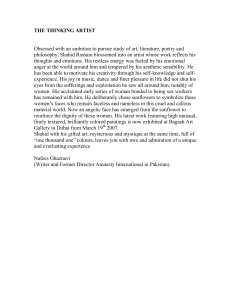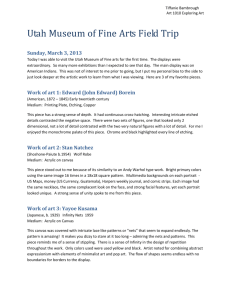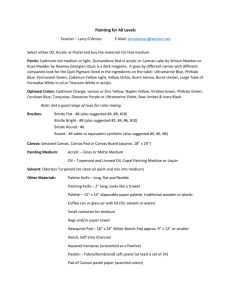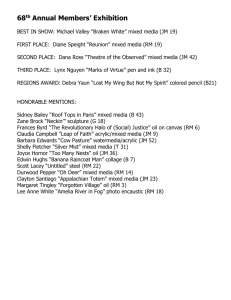I Worshippers and Sinners
advertisement
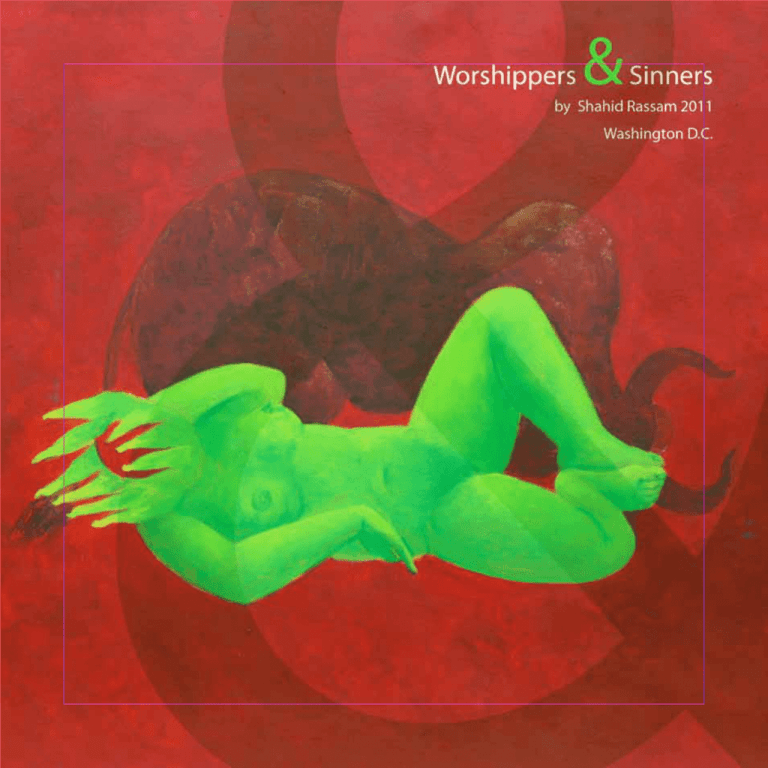
1 I Worshippers and Sinners 2 I Worshippers and Sinners 3 I Worshippers and Sinners I Worshippers and Sinners 1 I am not a teacher but an awakener. (Robert Frost) He tossed his pipes too hard to teach A new-world song, far out of reach, Time were changed from what they were: Such pipes kept less of power to stir They were pipes of pagan mirth, And the world had found new terms of worth. I wish to acknowledge the support of my friends and mentors: Mushtaq Ahmed Yousufi H.E Hussain Haqqani Anwer Maqsood Rashid Maqsood Hamidi Marjorie Hussain Dr. Enver Sajjad Dr. Akber Naqvi Tassaduq Sohail Saleem Haidery Zameer Rizvi Qudoos Mirza I Worshippers and Sinners Dr. Shafqat 2 Iftikhar Arif Murtaza Razvi Acknowledgment Hameed Haroon Aqueel Hassan Nageen Hayat Mrs. Zohra Hussain Sameera Raja Salwat Ali Mohsin Jaffery Mr. Shabs Peerzada Salman Hassan Mansoor Ashfaq Hussain Ehfaz-ur-Rehman M. F. Hussain Anish Kapoor And many other friends whom I am indebted to. Very special thanks to Ambassador Hussain Haqqani and staff of Embassy of Pakistan. Many many thanks to my family, my friend and mentor, my mother Rabia Yasin, my dearest friend my wife Nida and my universe, my sweet son Aabyan. Message from the Ambassador of Pakistan to The United States A Shahid has portrayed his entire work as if it is an ongoing dialogue – with self and society -- which draws its inspiration from the community, local and global, as he equally belongs to both. The greatness of his work thus lies in its profound appeal to many different groups. And because aesthetic experience is the most complete and integrated of our responses to the world, it is heartening to see the works of artists like Shahid who have become ambassadors of peace and humanity. His genuine desire to contribute to causes that he feels very strongly about elevates him as an artist and human being. Shahid Rassam’s use of symbolism and expressionist realism is a genuine effort on his part to spread the comforting message of peace and tolerance through this powerful medium of expression. I wish him every success in his artistic endeavors. HUSAIN HAQQANI February 2011, Washington D.C. I Worshippers and Sinners s an artist Shahid Rassam has used his creative impulse to promote peace and tolerance. Looking at Shahid’s work it becomes evident that the artist has used symbolism and metaphor as his medium of expression and has used his experiences to create works of art that are very much appreciated by art lovers and those who have an eye for finer things in life. 3 The Visual Poet A I Worshippers and Sinners sensitive, feeling heart, a brooding mind and a committed soul come together to form the leitmotifs that are Shahid Rassam’s very own. They are then punctuated with a master’s technique to put out reflections of an increasingly volatile society that the artist lives in. In this world of wonderment, truth and purity are burdened with strange bedfellows, who impose themselves on that which is beautiful and delicate to create a sinister offspring. These are not recurring dreams of primitive behavior, some so base that it hurts instantaneously, but a hall of mirrors in which the artist finds himself standing, dumbfounded. 4 Interpretations of the art at hand may vary from one culture to another, but to a Pakistani there’s no mistaking the powerful symbols present in the current body of Rassam’s work as a reflection of many prototypes, in all their crudity, that dog Pakistan today. The human body, albeit distorted, is the wronged, yet pure and beautiful, woman. She is known for her warm-clime fertility, like the land of the many gushing rivers that she hails from. Her head in the form of a sunflower tells of the bountiful soil that refuses to let go of its virility, standing as a testament to perseverance despite the odds stacked against her. In jest and through body curvature she cries out that there’s many a life left in her —despite her many tribulations. Her tormentor is the mean, malevolent bull, now sporting a beard, with all its base instincts that are all too in your face. The narrative moves on: the unnatural bedfellows give birth to an equally absurd offspring, who appears in the form of an egg, of the Jurassic Park variety, and which cannot wait to hatch. The palette then turns drastically solid: blues and oranges, agony staring at you… the rest is gray like the unknown swathes of the shade that bedevil a child in his deep sleep. And now the props: Amidst this emerging landscape, the dark night is stripped of its stars and the moon, La Luna, reflects the misery she sees down below, herself impregnated with ‘who knows what anymore’. The saxophone emanating from the female body and encompassing her soul, which once made music, will now likely echo with the loud cries of extremism, death and holy war; the bearded bull now controls the instrument to put it to his own, menacing use. Overtime, the fertile land too stops sprouting sunflower, and becomes rigidly terse and parched; cactus rears its thorny head where once lush abundance abounded. The night owl, the symbol of doom and gloom in traditional Eastern lore, lords over the burning moonscape as it were — another muddled contradiction in terms — as evident in the changing landscape that surrounds the lone artist. Besides the acrylics on canvas, the mix-media newspaper and charcoal drawings also speak of the phased tribulation of the fertile belle, and this is no Keatsian belle that knew no mercy, but one that is the victim of those who are sans mercy — the depraved and the evil. Rassam’s imagery and the accompanying idiom are firmly rooted in the Eastern, particularly Urdu, poetic tradition of which he is an ardent student. His visuals are the contemporary The current body of Rassam’s work, thus, reflects the mighty contradictions in society that he is up against, much like the poets before him, whom he adores and takes as his guides and mentors in thought. It is an elegy in visuals, just like the classical Urdu poetic genre of marsiya, the most poignant form in Urdu to register grief, give vent to anger against injustice and to deconstruct all that is evil, anti-social and revolting to human dignity and decent norms of civilized society. The beauty of the marsiya, like that of Rassam’s work, lies in this very noble attempt at deconstructing the evil, which is sought in order to restore and heal that which is pure, beautiful and sublime in life — thus, what better symbol to use than a woman’s bosom to depict all that purity, beauty and sublimity? The message of hope that shines through is this: ‘We’ve been there before, and defeated the demonic bulls that have tried to trample our soul; it is they who vanish; not we, nor our fertile land that is the belle that sings and dances like the sunflower.’ Murtaza Razvi December 2010, Karachi I Worshippers and Sinners counterfoils of the agony depicted by classical Urdu poets who documented very poignantly the horrors wrought on society by alien invaders, including the British, the loss of kingdom to alien rule, which rendered the local nobility destitute. They were poets like Mir Taqi Mir, who wrote in the aftermath of the sack of Mughal Delhi by the Afghan warrior, Ahmad Shah Abdali, in 1748; or Ghalib, who lamented over the misfortunes that stemmed from the 1857 Sepoys’ Rebellion which was christened as the War of Independence by Indian nationalists, or even the 20th century poet, Iqbal, who keenly eyed a post-colonial setup but worried about the ill-preparedness of Muslims to cope with the new, emerging modern world. Closer to our own time, Faiz Ahmed Faiz, Ahmed Faraz, Habib Jalib and Jaun Elia in Pakistan wrote heartrending poems, giving vent to the grief they suffered as sensitive practitioners of their own muses, be it on account of breakdown of human relationships and post-industrial alienation of the human soul or the squeezing of civil society by the tyranny of dictatorial rule, which eventually gave birth to the twin scourge of intolerance and extremism that is exercised in the name of religion today. 5 Through the Eyes of an Artist I n my capacity as an art journalist for the country’s leading daily newspaper, the Dawn, I have had occasion to view Shahid Rassam’s work in art exhibitions since he began to show his work in Karachi in the early ’90s. At that time he painted classical oriental subjects that appeared to have stepped out of the ‘Arabian Nights,’ curvaceous beauties in marble palaces, markets of legend with their beautiful, captive subjects on display and scenes from the Harems of eastern rulers. In these works Rassam assimilated design and architectural elements, creating narrative atmosphere with a fine eye for form and colour. I was privileged to have the opportunity to get to know him and to observe with interest his progress as an artist. During this period I witnessed his success as the recipient in several awards for art. I Worshippers and Sinners On the strength of his potential Rassam was awarded a British Council Scholarship to St. Martin’s School of Art, London, and there the subject and style of his work dramatically changed. In London he visited galleries and concerts and he developed a love of ballet finding the music and movements entrancing. He regularly queued for the students seats and made friends who shared his interests. When time came to work on a thesis, Rassam chose ‘Ballet Movements’ as his subjects leaving the world of myths and opulence far behind. 6 On his return to Karachi, the artist mounted an exhibition of paintings in 2002; it was titled: ‘Life is a Dome of Many Coloured Glass,’ and raised issues of vulnerable, exploited women in images rendered in a heavily impasto, dramatic style. He used interesting forms to express his viewpoint and stated: ‘the artist raises issues he does not offer solutions.’ His work continued to expand and he evolved an allegorical and figurative aesthetic language to research and communicates his experience of universal issues. He continued to work for exhibition and to contribute to group events abroad while regularly conducting workshops on art for universities in the UAE that at that time had no regular art syllabus. In Karachi he collaborated with the Arts Council to mount various programmes on art lectures and exhibitions. Always moving forward, Rassam began to express his views in the third dimension, moulding columns that fused a modern contemporary viewpoint with traces of a rich legacy. These were exhibited in UAE to acclaim. In the recent development of the symbolic sunflower series, the artist fragments his subject into diffused abstraction softening the distortion in his work with glimpses of limbs, traces of femininity and the solace of nature. Using layers of paint to create speckled, multi coloured textures he covers entire surfaces with a complex organization of mixed media, acrylic and oil compositions continuing the sensuous approach to the texture and colour of his paint. What one discovers in Shahid Rassam’s recent work is that it appears to be as much about contemplation as experience; life viewed by an empathetic philosopher. Though often symbolizing a darker side of life, yet the overall impression evokes a feeling of compassion for the fragility of life and human existence. The dramatic imagery discovers the subjects in a state of metamorphosis and dominated by the sunflower turning towards the sun by day and spent by the darkness of night. Ultimately it appears that Rassam’s work is no longer addressed by rage at the hopelessness of society in general, but now the intimate the observations of an on-looker, musing on the natural follies of mankind. Marjorie Husain December 2010, Karachi S trong and vibrating lines, colours, textures and intelligently crafty use of space, emerging in shapes reflecting human misery through human female which seems to be the ultimate human destiny but for one reservation-THE SUNFLOWER, mirror of light, warmth, energy, life and hope. Shahid Rassam has used effectively and very artistically symbolism to convey his anger at the fanatic intolerance, violence and oppression of women prevalent in our society and the world. Every symbol has a story of its own. He gathers hundreds of stories in a painting. Shahid paints whatever he wants to say about the status of women and society. It is up to the viewers and their level of understanding the artistic symbols and the strong social and political message that the artist is sending through his works. The more educated you are, the more you will be enjoying. I like Shahid Rassam’s technique and style, which are entirely his own. Tassaduq Sohail June 15, 2007 (Internationally known painter of Pakistan) Like always, Shahid will exhaust his present theme. We are waiting for your new probes, Shahid! Dr. Enver Sajjad August 20, 2004 (Painter, Writer and Dramatist) I Worshippers and Sinners A bout 400 years back in Europe symbolism became an important element in art to counter Church’s stranglehold on any artistic and literary expression, which it deemed blasphemous. Thus symbolism became an integral part of art and evolved into kind of a movement in art. Similar religious extremist stranglehold exists in Pakistan. Unfortunately our critics are far away from the reality and history. To me Shahid Rassam’s paintings are poems in colour set to music. He is not afraid of treading unknown paths and has always taken risks of experimentation in techniques, trying to capture human passions passionately, holding the throbbing pulse of his brush. 7 S hahid Rassam’s endeavour over ten years to evolve a personal imagery now revolves around the human and desire predicaments faced by women. He structures his imagery in semi figurative perception creating optical spaces with interplay of vertical and horizontal planes in which his texture play a dominant role. He has arrived at definitive imagery which unfolds enough opportunity for him to further experiment in carrying his aesthetic problems to the next stage in the evolution of his concept. Ali Imam (late) December 2001 (Legendary painter of Pakistan) 8 I Worshippers and Sinners 9 I Worshippers and Sinners Vincent van Gogh once said: “I dream of painting and then I paint my dream.” Perhaps by the same token my dreams are my paintings which turn into reality and sometimes turn reality into dreams. When they go through a creative journey to become a painting, you can see my beloved in it as well as the villain. The story of my paintings has a beloved who was the beloved of someone else in the 19th century – the darling of a creative individual who was madly in love with her, therefore immortalized her. After 150 years this beloved turns another artist into her admirer and a new account unfolds. I Worshippers and Sinners This story begins with a dream in which there is a beautiful princess who after some time assumes the form of a ballet dancer. When she dances the entire world gets mesmerized. Colors start to speak and silence starts to whisper. This crazy girl wins over the world not with her art, but with her body. 10 So the tale titled ‘The Oldest Profession’ kicks off from here. It also has many other faces in it. On occasion it exposes the monster within man and there are instants when it reveals the dancing beauty. Actually this beloved is a villain disguised as a beautiful creature. The creature then appears in the shape of newsprint drawings on business and economics pages and stands before a fiend, a wrongdoer called materialism, raising a pertinent question. This question begets a lot of other questions. And wearing the oldest profession’s crown this dancer makes her lover meet some new characters which congregate in big numbers. The most startling character among them is the one known as the worshipper. He has apparently immersed himself in the act of praying to God, but when I see him up close I get disturbed. That worshipper in reality is a bull -- and we all live in a china shop. He has a beard and the most ominous feature of his being is his eyes. He is always seen prostrating before God but his Imam, his spiritual leader, is the currency note, and he does not discriminate between dollar, euro or yuan. This story contains a great many dream-like questions and becomes the tale of sinners and worshippers. Now you may have guessed the love for the beloved, this love is my act of creation and the beloved is the sunflower. It has been going on for ages. Vincent and I fell in love with the same beloved, the sunflower. She is the beloved who has been showing us “the world of reality as well as the metaphorical world.” Somewhere down the line, the 21st century has set in. When I look back at things it seems like yesterday. I see that Vincent is still standing in the fields gazing at the sun and then looking at the sunflower (our mutual beloved). At dusk he encounters some sad, bleary-eyed children who work in the coalmines and now themselves look like pieces of coal. However, their cheeks are awash with tears and the tears in their eyes ask him why they hardly get to eat potatoes. (Love’s wrath has clean-swept my hearth Sans a desire-to-create I own nothing) (Ghalib) I Worshippers and Sinners I get up from there and come to my alter ego, Shahid, who like always gets bored with dreams, paintings, characters and tears. His criticism makes me tread on a path that leads to distinguished art collectors and reputed galleries, museums and auction houses. Shahid’s criticism begins with the phrase ‘style of the artist’ and he often asks me, “When will your beloved leave you? Till when are you going to see these frivolous characters? When will your art get rid of that dream and be able to see the reality of the world? When will you have your own style?” And I always fail to tell him that the answer to his questions is: “never”. My beloved and my immersion in work is my love, which is also my art, and which is also what my guru Pablo had taught me. According to him: “God is really only another artist. He created the sky, giraffes, elephants and the cats. He has no real style. He just goes on trying other things.” 11 SHAHID RASSAM February 2011, Toronto Profile of Shahid Rassam EDUCATION 1994-95 1998 1999 M.Sc. Geology, University of Karachi M.A. Urdu Literature, University of Karachi Awarded scholarship by the British Council at St. Martin College of Arts London I Worshippers and Sinners EXHIBITIONS 12 2011 2011 2008 2007 2006 2005 2004 2004 2003 2002 2001 2000 2000 1999 1999 1998 1997 1997 1996 1996 1996 1994 1991-92 Solo exhibition Embassay of Pakistan, Washington D.C. Live Painting demonstration on a unique musical composition, painting auctioned, Living art center, Toronto, Canada Solo Exhibition at Canvas Art Gallery. Karachi Solo Exhibition at Bagash Art Gallery, Dubai. Exhibition of mural Painting at Arts Council, Karachi Participated in a group exhibition, Rome, Italy Solo Exhibition at Chawkandi Art Gallery, Karachi Solo Exhibition at Nomad Art Gallery, Islamabad Participated in a group exhibition, Boston, USA Solo exhibition at Momart Art Gallery, Karachi Participated in a group exhibition of Art and Liberty in France, Belgium, Scotland Solo exhibition at Abu Dhabi Culture Foundation, UAE Solo exhibition at UAE University of Al-ain Solo exhibition at Abu Dhabi Culture Foundation, UAE Participated in a group exhibition at St. Martin College of Arts London Solo exhibition at Sheraton Hotel Dubai, UAE Group exhibition J.N.T.U. College of Arts Hyderabad, Daccan, India Solo exhibition Taj Gallery Mumbai, India Solo exhibition at Banh Belli project exhibition PNCA, Islamabad Solo exhibition at Banh Belli project exhibition Alhamra Arts Council Lahore, Solo exhibition at Banh Belli project exhibition Mehran Arts Council Mitthi, Thar Solo exhibition at Arts Council of Pakistan, Karachi Solo exhibition University of Karachi AWARDS 2000 1996 1995 1994 1991 Artist of the year, UAE University Al-ain Quaid-e-Azam youth award Quaid-e-Azam academy award Quaid-e-Azam portrait first prize Best artist award University of Karachi COMMISSIONED WORK • Produced commissioned work for over hundreds of clients from all over the world among these are 40 paintings to portray the life and culture of Thar desert commissioned by Banh Belli and UNICEF. • Buzkushi 20 x 9.5 feet mural commissioned by Government of Pakistan. • Mural 10 x 20 feet commissioned by an individual art collector in Dubai. • One oil painting auctioned for cancer patients at US$ 15,000. • 10 paintings commissioned by the private department of Sheikh Zayed including his own portrait for the palace. • Mural Painting auctioned for Earth quake victims US $ 20,000. MEMBERSHIPS AGO, Art Gallery Of Ontario, French Art Society, Art and Liberty UNESCO, AIAP Visiting Lecturer in UAE University Al-ain British Alumni Association Pakistan RASSAM STUDIO OF ART Tell: CANADA & USA: 001-647-969-8416, 416-917-4301 UK: 0044-7960729655 UAE: 00971-50-3218085, 4573618 PAK: 0092-300-2577411, 334-3080308 Email: shahid_rassam@yahoo.com shahid_rassam@hotmail.com www.shahidrassam.com website: photograph of works & potraits: Khalid Rassam, Mehmood Akhter I Worshippers and Sinners • Contributed with many paintings to raise funds for charitable causes. 13 I Worshippers and Sinners 14 Year 2010, Acrylic on Canvas I 30” x 36” Year 2010, Acrylic on Canvas I 30” x 36” 15 I Worshippers and Sinners I Worshippers and Sinners 16 Year 2010, Acrylic on Canvas I 30” x 36” I Worshippers and Sinners 17 Year 2010, Acrylic on Canvas I 40” x 50” I Worshippers and Sinners 18 Year 2010, Acrylic on Canvas I 30” x 36” Year 2010, Acrylic on Canvas I 30” x 36” 19 I Worshippers and Sinners 20 I Worshippers and Sinners Year 2010, Acrylic on Canvas I 30” x 36” 21 Year 2007, Newsprint with Charcoal I 24” x 30” I Worshippers and Sinners I Worshippers and Sinners 22 Year 2009, Acrylic on Canvas I 24” x 24” I Worshippers and Sinners 23 Year 2010, Acrylic on Canvas I 30” x 36” I Worshippers and Sinners 24 Year 2010, Acrylic on Canvas I 30” x 36” I Worshippers and Sinners 25 Year 2001, Joan Alia (Great Urdu Poet) Mixed Media on Canvas I 24” x 30” I Worshippers and Sinners 26 Year 2005, Worshippers Mixed Media on Canvas I 7 x 15ft 27 I Worshippers and Sinners I Worshippers and Sinners 28 Year 2009, Acrylic on Canvas I 30” x 36” I Worshippers and Sinners 29 Year 2010, Acrylic on Canvas I 30” x 36” I Worshippers and Sinners 30 Year 2007, Newsprint with Charcoal I 24” x 30” I Worshippers and Sinners 31 Year 2009, Acrylic on Canvas I 30” x 36” I Worshippers and Sinners 32 Year 2008, News Print with Charcoal I 22” x 28” I Worshippers and Sinners 33 Year 2009, Acrylic on Canvas I 40” x 50” 34 I Worshippers and Sinners Year 2009, Acrylic on Canvas I 22” x 24” 35 Year 2010, Acrylic on Canvas I 30” x 36” I Worshippers and Sinners I Worshippers and Sinners 36 Year 2009, Acrylic on Canvas I 24” x 24” I Worshippers and Sinners 37 Year 2009, Acrylic on Canvas I 30” x 36” Year 2010, Acrylic on Canvas I 30” x 36” 38 I Worshippers and Sinners I Worshippers and Sinners 39 Year 2009, Acrylic on Canvas I 22” x 24” 40 I Worshippers and Sinners I Worshippers and Sinners Year 2010, Acrylic on Canvas I 40” x 50” 41 Year 2010, Acrylic on Canvas I 30” x 36” I Worshippers and Sinners 42 Year 2010, Acrylic on Canvas I 30” x 36” Year 2009, Acrylic on Canvas I 24” x 36” 43 I Worshippers and Sinners I Worshippers and Sinners 44 Year 2010, Acrylic on Canvas I 30” x 36” I Worshippers and Sinners 45 Year 2007, Newsprint with Charcoal I 24” x 30” I Worshippers and Sinners 46 Year 2008, Whirling Dervaish, Gunmetal I 3ft high I Worshippers and Sinners 47 Year 2007, Bronz and Gunmetal I 3ft high I Worshippers and Sinners 48 Year 2008, Raqsay Zanjeer (dance in chain) Bronz I 3ft high I Worshippers and Sinners 49 Year 2008, Come and Cast the first Stone Gunmetal I 3ft high 50 I Worshippers and Sinners 51 I Worshippers and Sinners Thine emulous fond flowers are dead, too, And the daft sun-assaulter, he That frightened thee so oft, is fled or dead; Save only me (Nor is it sad to thee!) Save only me There is none left to mourn thee in the fields.. I Worshippers and Sinners (ROBERT FROST) 52
